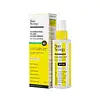What's inside
What's inside
 Key Ingredients
Key Ingredients

 Benefits
Benefits

 Concerns
Concerns

 Ingredients Side-by-side
Ingredients Side-by-side

Water
Skin ConditioningEthylhexyl Salicylate
UV AbsorberButyl Methoxydibenzoylmethane
UV AbsorberOctocrylene
UV AbsorberGlycerin
HumectantBetaine
HumectantCoco-Caprylate
EmollientZinc Oxide
Cosmetic ColorantStearic Acid
CleansingPhenoxyethanol
PreservativeCetyl Alcohol
EmollientGlyceryl Stearate
EmollientAmmonium Acryloyldimethyltaurate/Vp Copolymer
Propylene Glycol
HumectantMenthol
MaskingMethyl Diisopropyl Propionamide
MaskingEthyl Menthane Carboxamide
TonicMenthyl Lactate
MaskingHydroxypropylcellulose
EmulsifyingTocopheryl Acetate
AntioxidantAloe Barbadensis Leaf Extract
EmollientChamomilla Recutita Flower Extract
MaskingAvena Sativa Kernel Extract
AbrasiveCaesalpinia Spinosa Fruit Extract
Skin ProtectingHelianthus Annuus Sprout Extract
Skin ConditioningCitrus Aurantium Dulcis Peel Oil
MaskingRosmarinus Officinalis Leaf Oil
MaskingSodium Benzoate
MaskingDisodium EDTA
Sodium Hydroxide
BufferingWater, Ethylhexyl Salicylate, Butyl Methoxydibenzoylmethane, Octocrylene, Glycerin, Betaine, Coco-Caprylate, Zinc Oxide, Stearic Acid, Phenoxyethanol, Cetyl Alcohol, Glyceryl Stearate, Ammonium Acryloyldimethyltaurate/Vp Copolymer, Propylene Glycol, Menthol, Methyl Diisopropyl Propionamide, Ethyl Menthane Carboxamide, Menthyl Lactate, Hydroxypropylcellulose, Tocopheryl Acetate, Aloe Barbadensis Leaf Extract, Chamomilla Recutita Flower Extract, Avena Sativa Kernel Extract, Caesalpinia Spinosa Fruit Extract, Helianthus Annuus Sprout Extract, Citrus Aurantium Dulcis Peel Oil, Rosmarinus Officinalis Leaf Oil, Sodium Benzoate, Disodium EDTA, Sodium Hydroxide
Butyl Methoxydibenzoylmethane 2.8%
UV AbsorberHomosalate 9.8%
Skin ConditioningEthylhexyl Salicylate 4.9%
UV AbsorberOctocrylene 9.5%
UV AbsorberAlcohol Denat.
AntimicrobialButyloctyl Salicylate
Skin ConditioningCamellia Sinensis Leaf Extract
AntimicrobialCananga Odorata Flower Oil
MaskingCaprylic/Capric Triglyceride
MaskingCitrus Aurantifolia Oil
CleansingCitrus Grandis Peel Oil
MaskingCitrus Medica Peel Oil
Citrus Nobilis Peel Oil
MaskingCitrus Reticulata Leaf Oil
MaskingCitrus Sinensis Peel Oil Expressed
PerfumingDicaprylyl Carbonate
EmollientDiisopropyl Adipate
EmollientEthyl Ferulate
AntioxidantEuterpe Oleracea Fruit Extract
Helianthus Annuus Seed Oil
EmollientIsodecyl Neopentanoate
EmollientLavandula Angustifolia Oil
MaskingMentha Piperita Oil
MaskingMentha Viridis Leaf Oil
AstringentTetrahexyldecyl Ascorbate
AntioxidantTridecyl Neopentanoate
EmollientVa/Butyl Maleate/Isobornyl Acrylate Copolymer
Vitis Vinifera Seed Oil
EmollientButyl Methoxydibenzoylmethane 2.8%, Homosalate 9.8%, Ethylhexyl Salicylate 4.9%, Octocrylene 9.5%, Alcohol Denat., Butyloctyl Salicylate, Camellia Sinensis Leaf Extract, Cananga Odorata Flower Oil, Caprylic/Capric Triglyceride, Citrus Aurantifolia Oil, Citrus Grandis Peel Oil, Citrus Medica Peel Oil, Citrus Nobilis Peel Oil, Citrus Reticulata Leaf Oil, Citrus Sinensis Peel Oil Expressed, Dicaprylyl Carbonate, Diisopropyl Adipate, Ethyl Ferulate, Euterpe Oleracea Fruit Extract, Helianthus Annuus Seed Oil, Isodecyl Neopentanoate, Lavandula Angustifolia Oil, Mentha Piperita Oil, Mentha Viridis Leaf Oil, Tetrahexyldecyl Ascorbate, Tridecyl Neopentanoate, Va/Butyl Maleate/Isobornyl Acrylate Copolymer, Vitis Vinifera Seed Oil
Ingredients Explained
These ingredients are found in both products.
Ingredients higher up in an ingredient list are typically present in a larger amount.
Also known as Avobenzone, this ingredient is a chemical sunscreen filter that provides protection in the UV-A range.
Avobenzone is globally approved and is the most commonly used UV-A filter in the world.
Studies have found that avobenzone becomes ineffective when exposed to UV light (it is not photostable; meaning that it breaks down in sunlight). Because of this, formulations that include avobenzone will usually contain stabilizers such as octocrylene.
However, some modern formulations (looking at you, EU!) are able to stabilize avobenzone by coating the molecules.
Avobenzone does not protect against the UV-B range, so it's important to check that the sunscreen you're using contains other UV filters that do!
The highest concentration of avobenzone permitted is 3% in the US, and 5% in the EU.
Learn more about Butyl MethoxydibenzoylmethaneEthylhexyl Salicylate is an organic compound used to block UV rays. It primarily absorbs UVB rays but offers a small amount of UVA protection as well.
Commonly found in sunscreens, Ethylhexyl Salicylate is created from salicylic acid and 2-ethylhexanol. You might know salicylic acid as the effective acne fighter ingredient and BHA.
The ethylhexanol in this ingredient is a fatty alcohol and helps hydrate your skin, similar to oils. It is an emollient, which means it traps moisture into the skin.
According to manufacturers, Ethylhexyl Salicylate absorbs UV wavelength of 295-315 nm, with a peak absorption at 307-310 nm. UVA rays are linked to long term skin damage, such as hyperpigmentation. UVB rays emit more energy and are capable of damaging our DNA. UVB rays cause sunburn.
Learn more about Ethylhexyl SalicylateOctocrylene protects skin from sun damage. It absorbs UV-B with peak absorption of 304 nm. It is a common sunscreen ingredient and often paired with avobenzone, a UVA filter. This is because octocrylene stabilizes other sunscreen ingredients by protecting them from degradation when exposed to sunlight. Octocrylene is a photostable ingredient and loses about 10% of SPF in 95 minutes.
Octocrylene also acts as an emollient, meaning it helps skin retain moisture and softens skin. It is oil-soluble and hydrophobic, enhancing water-resistant properties in a product.
Those who are using ketoprofen, a topical anti-inflammatory drug, may experience an allergic reaction when using octocrylene. It is best to speak with a healthcare professional about using sunscreens with octocrylene.
The EU allows a maximum of these concentrations:
Learn more about Octocrylene